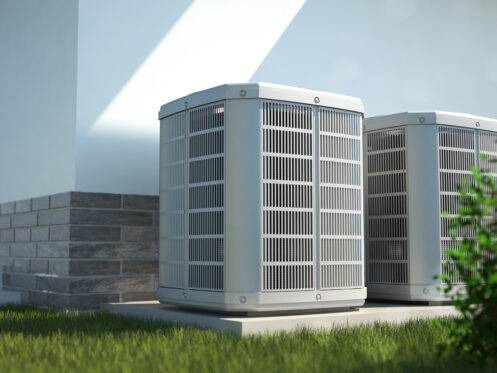If there are multiple people living in your Sioux City, IA home, you’ve probably had more than one argument at the thermostat. Central HVAC systems heat and cool homes uniformly. They establish and maintain the same temperature in all areas. Not only does this fail to account for the vastly different needs of building residents, but it also leads to considerable energy waste. Fortunately, homeowners can now enjoy the enhanced comfort, convenience, and efficiency of central HVAC zoning. Read on to find out what this is and why it works so well.
What Is HVAC Zoning?
HVAC zoning divides buildings and the ductwork that supports their heating and cooling systems into separate service areas or zones. If you have a two-story home, you might have one zone upstairs and one on the first floor. Most central HVAC systems can handle up to four zones. As such, you can have your home sectioned off by floors, areas of high and low use, or areas that get lots of natural temperature regulation versus those that do not.
In zoned systems, each zone has its own thermostat and each thermostat is controlled independently of the others. This way, raising the thermostat setting in an upstairs area won’t result in the inflow of heat to an empty, downstairs room.
How HVAC Zoning Systems Are Installed
When zoning central HVAC systems, we install duct dampers and bypass ducts to section off HVAC ducting. When conditioned air is no longer needed in a space, the related duct dampers seal shut. Bypass ducts prevent dramatic rises in air pressure within HVAC ductwork by providing a secondary space for unneeded air to flow. In so doing, bypass ducts limit stress on HVAC equipment and support optimal airflow.
All of the components of a zoned HVAC system are governed by a central control unit. Each thermostat is connected to this unit and sends out signals when its temperature setting is raised or lowered. Central control units use these signals to determine which dampers to open and close to create the desired conditions in each respective area.
HVAC Air Vent Closures vs. HVAC Zoning
Understanding how zoned HVAC systems work, you might think it more cost-effective to simply close air vents in unoccupied spaces or areas in which residents don’t want conditioned air. However, contrary to what many consumers believe, HVAC air vents aren’t really intended for redirecting air or customizing heating and cooling delivery. In fact, after your HVAC installer has set your vents in the correct positions, it’s best to avoid closing them at all.
Closing HVAC air vents will stop the flow of conditioned air into the related rooms, but lacking bypass ducts, this air will have nowhere to go. This leads to the build-up of static pressure in ducting and it can cause HVAC systems to short-cycle, overheat, and shut down.
When you have air balancing services performed, HVAC technicians make slight, strategic adjustments to all air vents throughout the building. These adjustments optimize the flow of conditioned air, prevent in-system stress, and minimize the risk of hot and cold spots. When residents close their vents temporarily, they cannot guarantee that they’ll be able to put these components back into their ideal positions when reopening them.
Zoned HVAC Systems Require Smart Thermostats
Upgrading to a zoned HVAC system will give you the chance to experience the impressive capabilities of smart thermostats firsthand. While programmable thermostats can be programmed by homeowners to make a series of scheduled temperature changes throughout the day, smart thermostats are actually learning devices. They study the movements, schedules, and preferences of residents, collect data on local weather, and track both energy consumption and HVAC system use. Over time, they become evermore adept at adjusting themselves.
Smart thermostats also provide detailed reports on changes in energy use and other factors. You can use these reports to determine the best efficiency upgrades for your home and to inform your future purchasing decisions.
How Much Can HVAC Zoning Help You Save?
When performed correctly, HVAC zoning could shave up to 30% off your home energy bill. With HVAC system use accounting for approximately 50% of the average household’s total energy use, zoning can also dramatically reduce your carbon footprint. Best of all, these are improvements that you’ll enjoy without having to compromise your comfort in the process. In fact, with the right zoning plan, this transition could make your living space more enjoyable for everyone.
Properly zoned HVAC systems often last a lot longer as well. When heaters, air conditioners, and heat pumps have less work to do, they sustain less wear overall. This can also lead to fewer breakdowns and less money spent on repairs. When accounting for these benefits, zoning systems ultimately pay for themselves.
Is a Zoned HVAC System Right for Your Household?
Like many homeowners, you may be concerned about having multiple thermostats throughout the building that allow residents to make temperature adjustments at their discretion. This is an understandable concern when there are small children, teenagers, and other people who might crank the thermostat way up or way down or make other costly decisions. However, given that zoned HVAC systems are governed by smart thermostats, you’ll retain total control over how these devices are used.
You can program your smart thermostats to make temperature adjustments according to your preferred schedule. You can also use these devices’ branded apps to track and alter the temperature adjustments that other residents make while you’re away. When necessary, you can even manually adjust these devices to save money, better regulate indoor conditions, or remove settings made by residents that aren’t in line with your budget or goals.
You should consider zoning your HVAC system if residents are constantly bickering about your thermostat setting and your indoor temperature. These upgrades also work well in households in which residents have radically different schedules. For instance, if you have college-age children who come home on the weekends or for holidays but leave their rooms unoccupied at other times, zoning will divert heated and cooled air away from these spaces to prevent energy waste.
Integrated HVAC System Accessories and HVAC Zoning
HVAC zoning comes with an important caveat: integrated HVAC system accessories might not work as well. For instance, if you have a whole-house air purifier, air scrubber, or dehumidifier installed, you may need to have a separate unit for each zone. If you rely on these secondary technologies to regulate indoor moisture or improve your indoor air quality (IAQ), you can work with our technicians to determine the best way to make everything work together. We’ll consider the needs of your household, the nuances of your HVAC system, and the type of accessories installed. We’ll also explain the benefits and drawbacks of each possible system modification so that you can make informed decisions about your HVAC system’s overall design.
Keeping residents of Sioux City, IA comfortable has been our top priority for more than 100 years. We offer furnace, air conditioner, and heat pump installation, maintenance, and repairs. We also provide radiant heat systems, indoor air quality improvements, HVAC zoning, and duct sealing. Contact Kalins Indoor Comfort now to schedule an appointment!











